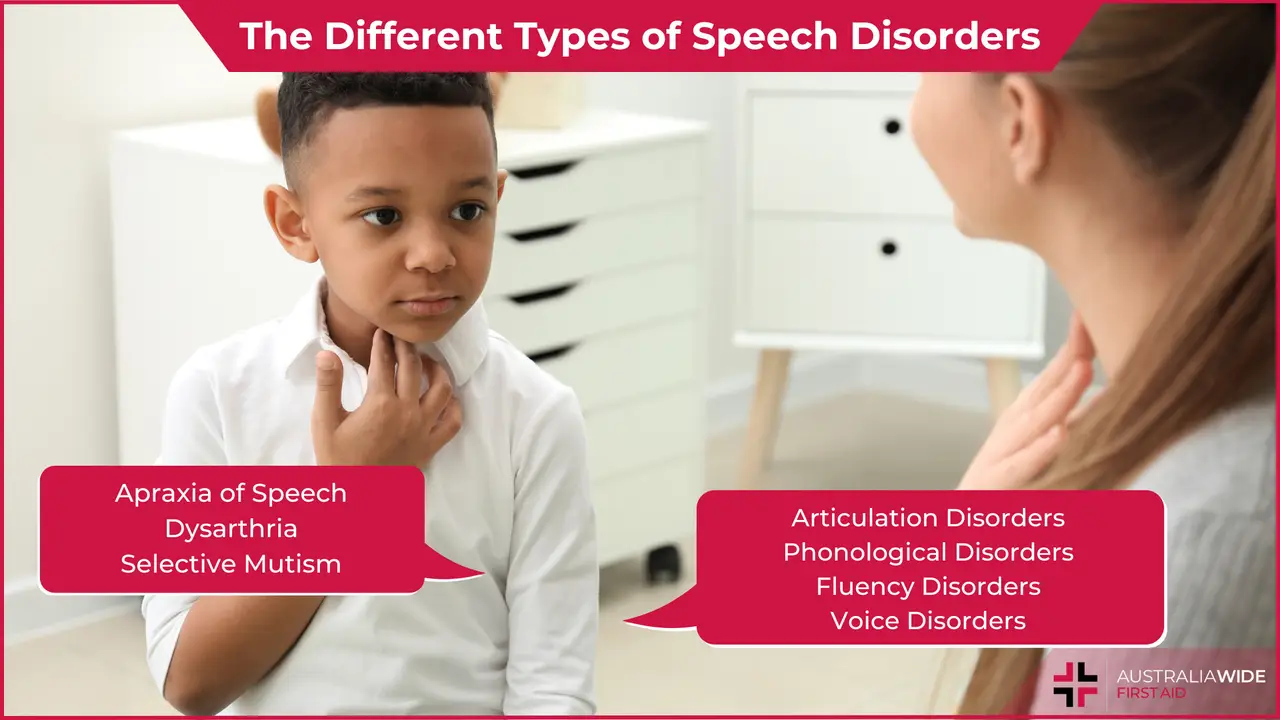The Different Types of Speech Disorders


Speech disorders are conditions that affect a person's ability to produce speech sounds correctly or fluently.
As part of the larger family of communication disorders, it is important to note that these are separate from language disorders, which impact a person’s ability to effectively use language.
The various types of speech disorders highlight the unique challenges people may face in expressing themselves effectively. These disorders can impact not only the person's ability to communicate but also their self-esteem, social interactions, and overall quality of life.
They are more common in children, caused by biological factors, developmental disorders, medical conditions, and behavioural and psychological factors.
Adults who did not grow up with a speech disorder can still develop one. Often this occurs through trauma to the brain such as injury or stroke, degenerative diseases, or hearing loss.
There are many different types of speech disorders, each with its own causes, symptoms, and progression.
Articulation is the name for producing sounds. This involves the coordinated movement of the tongue, lips, teeth, palate (top of the mouth), he respiratory system, and many muscles and nerves.
An articulation disorder involves difficulties in forming speech sounds correctly and/or producing particular sounds.
People with articulation disorders may omit, substitute, or distort sounds.
Examples include substituting ‘w’ for ‘r’ sounds, or having a lisp.
Phonology refers to the way a sound is produced, and how these sounds are arranged together to make words.
While able to produce a sound correctly, phonological disorders affect a person's ability to organize and use speech sounds within a language. This can result in pattern-based errors that affect multiple sounds.
Examples include using a sound in the wrong word, or in the wrong position within the correct word. It can also include omitting sounds from some words but not others.
People with fluency disorders experience disruptions in the normal flow of speech.
This can lead to repetitions, where the person says a word or parts of a word more than once. It can also lead to unusual pauses between words.
While usually involving whole words, it can also involve blocks of sounds or syllables.
Stuttering is a well-known example of a fluency disorder. Another example is cluttering, where a person may speak too fast, cut off parts of words, and merge words together.
These involve abnormalities in the pitch, volume, or quality of the voice. They occur when the vocal cords don’t vibrate normally.
Sometimes a person with a voice disorder will sound hoarse, have a quavering sound, sound strained or whispery, or sound too high or low pitch.
Voice disorders can result from physical issues with the vocal cords, misuse of the voice, or psychological factors. For example laryngitis (when the vocal cords swell) and spasmodic dysphonia (a nerve issue) both cause voice disorders.
Apraxia of speech is a neurological disorder that affects the motor planning and coordination needed for speech production. It is commonly known as childhood apraxia of speech in children, and acquired apraxia of speech in adults who did not develop it as a child.
While the person will be able to move their face and mouth well for eating and facial expressions, and they know exactly what they want to say, they cannot form the pathways necessary for saying those words out loud.
People with apraxia of speech have difficulty, at the brain-muscle level, planning and executing the precise movements required for speech sounds.
They can often be very difficult to understand, as the ability to produce sounds consistently and accurately varies.
Dysarthria is a motor speech disorder caused by muscle weakness or paralysis. It is usually caused by damage to the brain, or to the nerves involved in speech sound production.
It affects the coordination and strength of the muscles involved in speech production, resulting in slurred or difficult-to-understand speech.
Both children and adults can have dysarthria, and speech therapies are often effective in improving this particular condition.
Selective mutism is an anxiety-related disorder where individuals consistently fail to speak in certain social situations, despite speaking in others.
People with selective mutism don’t choose to be silent – they want to speak, and know what they want to say, but their anxiety stops them.
For example, they may speak comfortably with family members, but be unable to speak to strangers, or at school.
The realm of speech disorders is a complex and diverse field that underscores the intricate nature of human communication.
Understanding the underlying causes of speech disorders, whether they are developmental, neurological, or acquired, is crucial for tailored intervention strategies.
Early detection and intervention play a pivotal role in minimizing the long-term effects of these disorders, enabling people to build stronger communication skills and fostering a sense of empowerment.
As society becomes increasingly inclusive, it is paramount to raise awareness and promote understanding of speech disorders. This not only reduces stigma but also encourages empathy and patience.
By recognizing the diversity of speech disorders and embracing the uniqueness of every individual's communication journey, we can foster a more compassionate and communicatively rich world for everyone.

March 25, 2025
Explore non-traditional paths to sobriety, including mindfulness, yoga, nutritional therapy, and community-based support, for a personalized approach to recovery.

September 7, 2022
Menopause is the final period, when a woman, trans man, or non-binary person assigned female at birth's ovaries run out of eggs and the body can no longer ovulate. Menopause comes with several symptoms, complications, and treatment options.

July 26, 2024
Transcutaneous Electrical Nerve Stimulation (TENS) is a therapeutic method of pain relief. It utilises an electrical device that emits electrical currents and streams the impulses via electrode patches attached to the skin.